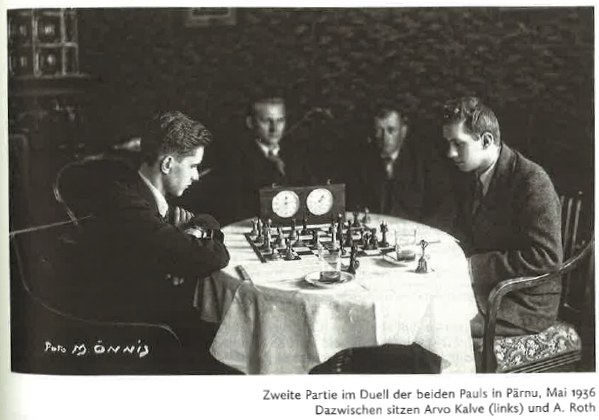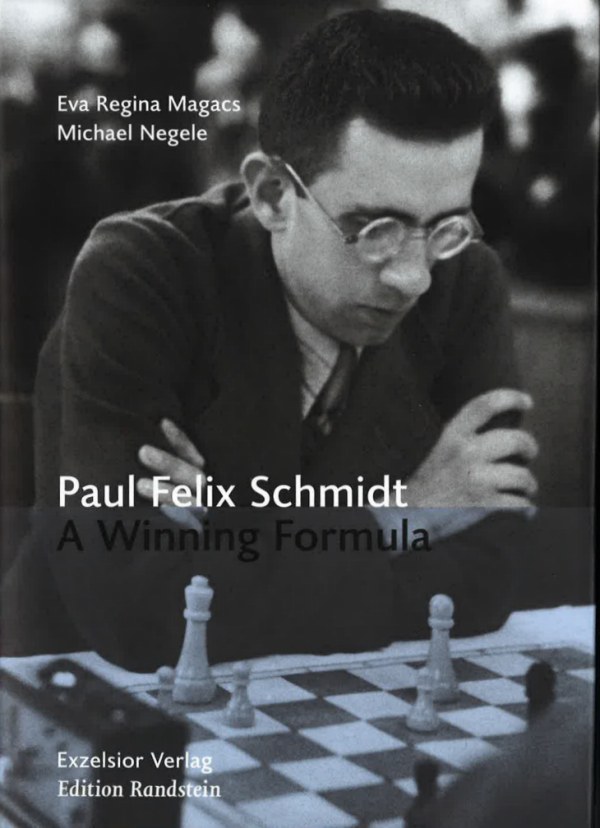


If you ever looked at game collections by Paul Keres chances are that you came across the name Paul Felix Schmidt. "Schmidt" is a very German name but like Keres Schmidt was Estonian - at least politically. He had a German-Baltic background and like Keres Schmidt was born in Narva. The two were also born in the same year: Keres on January 7, 1916, Schmidt on August 20, 1916.
The biographies and chess careers of Keres and Schmidt were both heavily influenced by the turbulent times into which they were born. In 1916 Estonia was still part of the czarist Russian Empire but after World War I, the Russian Revolution, and the Estonian War of Independence, Estonia became independent in 1920. But in 1940, during the Second World War and after the German-Soviet-Non-aggression Pact, the country was occupied by Soviet troops. However, in June 1941 the Germans broke the Non-aggression pact, invaded the Soviet Union, and occupied Estonia in July 41. But in 1944, when the German armies were retreating in the East, the Soviets reoccupied Estonia again. After the end of the Second World War Keres became a Soviet citizen while Schmidt moved to the Southwest of Germany and later emigrated to the USA.
17 of the games which Keres and Schmidt played from 1933 to 1943 have survived and found their way into the databases. Surprisingly, the score in these games is absolutely equal: both won six times and five games were drawn. Seven of these 17 games were played in a match that Keres and Schmidt contested in 1936 and that ended 3½-3½.

Paul Keres and Paul Schmidt
If you have a life-time equal score against Keres you must have been a very strong player. Which Schmidt was indeed: in 1936 and 1937 he was National Champion of Estonia and played for Estonia in two Chess Olympiads. In 1941 he shared first place with Klaus Junge at the German Championship in Bad Oeynhausen and later won the tie-break and the title.
In 1939, at the outbreak of World War II, Schmidt was 23 years old, and during the war he played in several tournaments in German territory. In 1941, at the Championship of the General Government (the occupied Poland) he shared first place with Alexander Alekhine. According to statistician Jeff Sonas at that time Schmidt had a historical rating of 2696 and was the world's number nine.
After the end of the war Schmidt, who was a graduated chemist, played a couple of tournaments in Germany and got his PhD in chemistry from the University of Heidelberg in Germany. In 1949 he published his little book Schachmeister denken (Chessmasters think) and in 1952 he decided to emigrate to the US. In Philadelphia he began a new life as a chemist and vanished from the world of chess which soon hardly remembered him.
For a long time Schmidt remained "the great unknown" but thanks to the work of German chess historian Michael Negele we now know more about this strong chess player: in cooperation with Schmidt's daughter, Eva Regina Magacs, Negele wrote and published the book Paul Felix Schmidt - A winning formula.
Though the book contains an appendix with twelve selected and annotated games and an overview of the tournaments Schmidt played in, this is is not a run-of-the-mill biography of a chess player that focuses on tournaments and games. But it is definitely a biography, and even more, a kind of family saga, in which the central character is a chess player uprooted from his native country by the erratic course of history who against the course of history tries to realise himself as a chess player to finally find peace and success in an entirely different field in a different country.
Michael Negele's and Eva Regina Magacs' book about Paul Felix Schmidt is the result of diligent and persistent detective work. It began with the surviving games of Schmidt and his little book Schachmeister denken. Taking this as a point of departure Negele step by step found out more about Schmidt and finally was able to contact Schmidt's daughter in the USA which gave him access to a number of memorabilia which otherwise might have been forgotten.
The paternal side of the Schmidt family came from the "Erzgebirge". Gustav Max Schmidt, the great grandfater of Paul Felix, came in the middle of the 1850s as a teacher to what then was Livonia, and eventually founded a teaching institute with boarding school. In this school chess was very popular. One of the students was Friederich Amelung, later a leading figure in Baltic chess circles. For generations chess was also a popular passion in the Schmidt family, and Max Leopold Schmidt, the grandfather of Paul Felix Schmidt, was already a member of the chess club of Riga.
At the end of World War I Paul Roderich Schmidt, father of Paul Felix, tried to escape the political unrest in the Baltic countries and fled with his family to Hannover in Germany where he immediately joined the local chess club. Paul Roderich was a chess enthusiast who taught his son the rules of the game when Paul Felix was just three-and-a-half years old.
In 1923 the family returned to Estonia because of the difficult economical situation in Germany. In Estonia Paul Roderich and Paul Felix both regularly played in chess tournaments and matches. In 1930 Schmidt senior and Schmidt junior both won against Efim Boguljubow in a simul in Tallinn. In 1935 the 19-year old Paul Felix Schmidt won the international tournament to celebrate the 50-year old jubilee of the society of the chess friends Tallinn ahead of Keres. The beginning of a great but much too short career.

Jubilee tournament Tallinn
 If you are interested in chess history and/or history in general you will find a lot of interesting and exciting material in the 310 pages of this book. Michael Negele, Eva Maria Magacs, and Paul Felix Schmidt invite you to travel back in time to a part of history that is less well-known. The book is divided into two parts: one part tells the story of the life of Paul Felix Schmidt and is in English, the other part is more documental, mainly in German and enriched with historical photos and documents. But both parts offer the reader a wealth of historical insights.
If you are interested in chess history and/or history in general you will find a lot of interesting and exciting material in the 310 pages of this book. Michael Negele, Eva Maria Magacs, and Paul Felix Schmidt invite you to travel back in time to a part of history that is less well-known. The book is divided into two parts: one part tells the story of the life of Paul Felix Schmidt and is in English, the other part is more documental, mainly in German and enriched with historical photos and documents. But both parts offer the reader a wealth of historical insights.
Published by Exzelsior, 2017
English and German
ISBN-10: 3935800088
ISBN-13: 978-3935800082
39.80€
Translation from German: Johannes Fischer